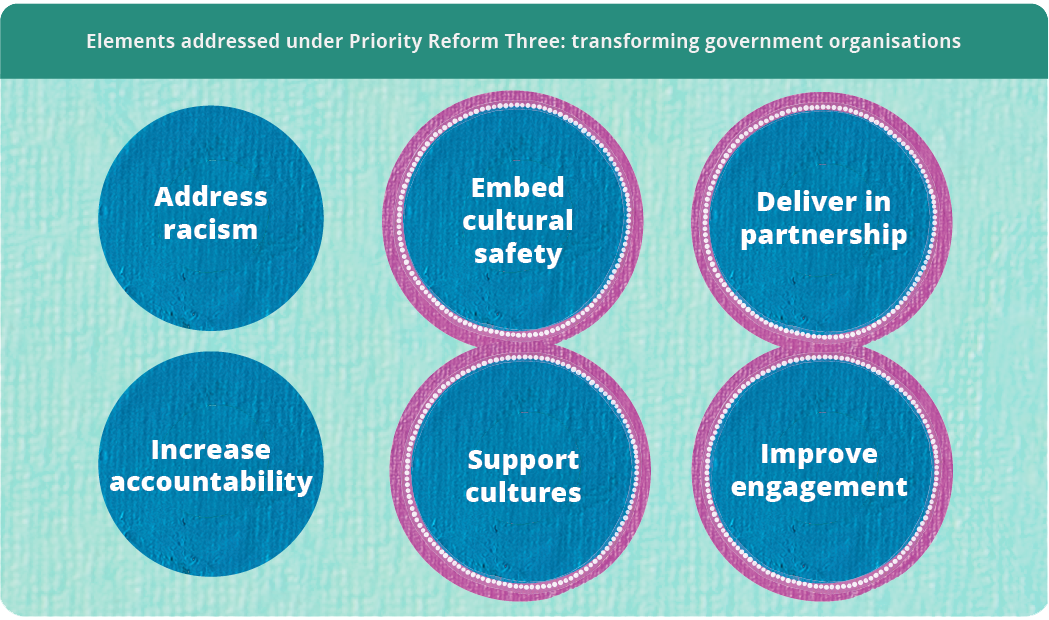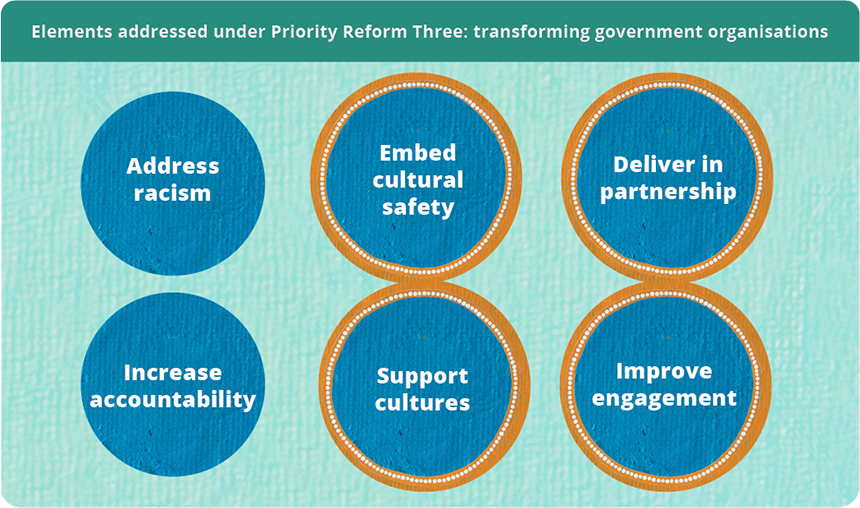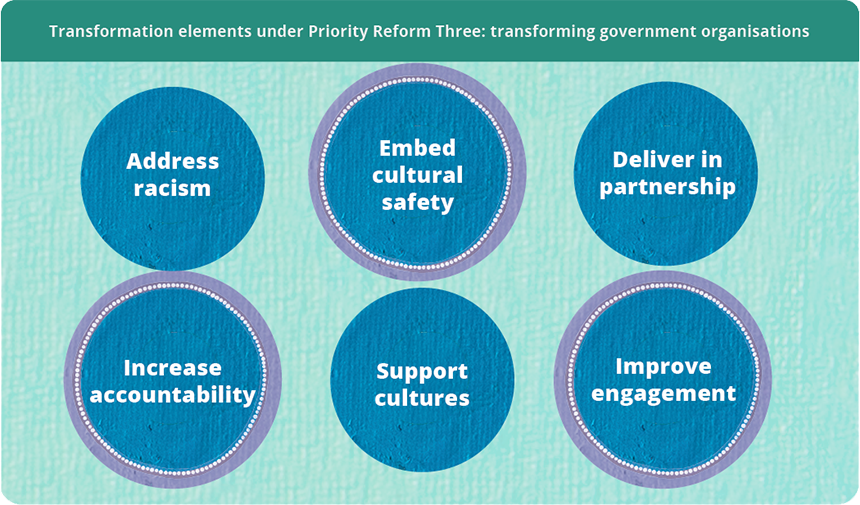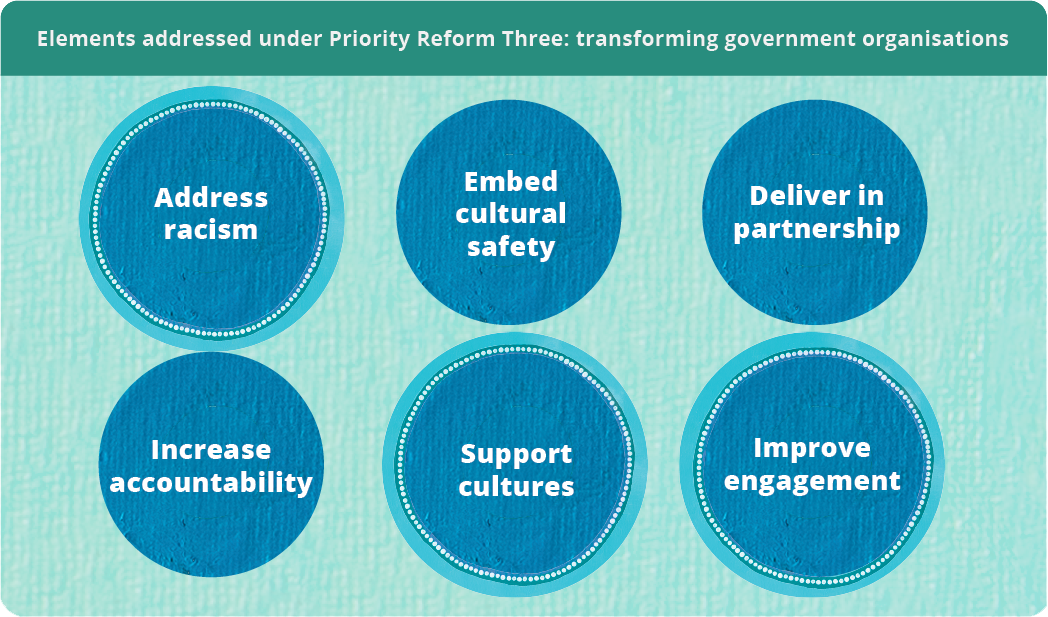Case studies

The Productivity Commission (PC) is highlighting pockets of good practice within government to share knowledge on what transformative action looks like and what it takes to achieve it. With the support of agencies and their partners implementing change, the PC has developed case studies and practical guidance for public servants to draw on to learn, adapt and implement.
This will be an ongoing project, with new cases and guidance added over time.
How we develop the case studies
The PC worked closely with the Coalition of Peaks Secretariat to plan and design the research project. Together, we identify and review case studies based on the criteria that the policy, initiative or program:
- was developed in partnership with Aboriginal and Torres Strait Islander people, organisations or communities
- is aligned with the Priority Reforms and socio-economic outcome areas of the National Agreement on Closing the Gap
- has learnings that can be adopted and scaled across governments.
For each case study, we collaborate with organisational representatives to define the scope, design the interview structure and questions, and refine the final output.
The evolution of Connected Beginnings shows the value of investing in genuine partnerships with the community-controlled sector.
Following the announcement of Connected Beginnings as a key Commonwealth Closing the Gap measure in 2021, the Department of Education and the Department of Health, Disability and Ageing formally partnered with peak bodies SNAICC – National Voice for our Children and the National Aboriginal Community Controlled Health Organisation to align the program with the Priority Reforms.
This includes supporting the transition of funding from mainstream organisations to Aboriginal Community Controlled Organisations, improving site selection processes, and taking a relational approach to grants administration. These efforts have strengthened local leadership and governance, resulting in a more culturally appropriate and responsive program.
Key points
- Navigating partnerships across portfolios demands deliberate effort and sustained coordination. This helps align roles, foster mutual understanding and reconcile different ways of working, leading to better decisions and outcomes.
- Strong partnerships with the community-controlled sector require early investment in building rapport, trust and sound governance structures. Secondment arrangements can fast-track trust and capacity building with the sector.
- Taking a relational approach to grant administration is crucial. Direct administration of grants can provide greater flexibility to build relationships which go beyond the traditional funder-grantee arrangements and provide bespoke support.
- Tailored guidelines and frameworks can support both organisation and community readiness to transition services from mainstream organisations to the community-controlled sector.
- Site selection processes can be enhanced by combining strengths-based data with sustained community engagement and shared governance with community partners. This supports more informed, culturally appropriate and transparent decision-making.

This case shows how government agencies can begin transforming their practices and services in line with Priority Reform Three, through co-design.
With the support of the South Australian Health Minister, the Department for Health and Wellbeing led a statewide co-design process in partnership with Aboriginal and Torres Strait Islander people to improve the cultural responsiveness of the South Australian health system.
An independent evaluation found the process created a connected network of senior leaders across the health system. It also increased statewide coordination that will endure beyond the program.
Key points
- Genuine co-design can transform systems when agencies invest in relationships, formalise shared decision-making, and value lived experience and cultural authority.
- Building strong, trusted relationships is as important as securing funding or establishing appropriate governance.
- Funding partners to engage with their communities to develop and test reforms enables localised approaches and integration of cultural knowledge.
- Partnering at every stage of the commissioning cycle supports sustainable capacity building.
- Defining co-design with partners and formalising agreed ways of working upfront keeps government officials from slipping back to business-as-usual approaches. Delivering on these commitments builds the trust needed for genuine partnership.
- Effective co-design improves system coordination by deepening relational networks across sectors and fostering active community engagement.

This case study is about governments reimagining budget development in line with the Priority Reforms.
NSW Government and the NSW Coalition of Peak Organisations created a process for budget submissions which brought together community partners and government agencies to develop and prioritise business cases. The model was used to create cross-portfolio budget submissions for the 2022-23 and 2025-26 budget processes.
This led to greater community control over government spending related to Closing the Gap, supporting self-determination and directing funding to areas identified by Aboriginal and Torres Strait Islander community-controlled organisations as greatest need.
Key points
- Aboriginal and Torres Strait Islander people are best placed to identify the needs and priorities of their communities, but budget decisions are largely made by governments.
- Working in partnership with Aboriginal and Torres Strait Islander people and organisations through shared governance structures, governments can share decision-making in budget development.
- With appropriate support, Aboriginal and Torres Strait Islander people and organisations can participate as equal partners in developing and prioritising business cases for budget submission.
- Budget processes present limits to shared decision-making that require active and sustained support from ministers, secretaries, and agency staff to create an authorising environment for collaborative budget development.
- To encourage collaborative policy and budget design processes as business-as-usual, governments should consider co-developing shared decision-making structures, updating submission guidance and increasing transparency in funding decisions and outcomes.

The Commonwealth Scientific and Industrial Research Organisation (CSIRO) is changing its ways of working to centre the knowledge and priorities of Aboriginal and Torres Strait Islander communities.
Following deep listening both internally and externally, CSIRO developed a strategic approach to reform their research governance, engagement, funding, communications and workforce to build capability to support Aboriginal and Torres Strait Islander-led and driven research solutions.
This is creating space for research informed by Aboriginal and Torres Strait Islander communities’ priorities, aspirations and interests, that delivers long term economic benefits and outcomes to communities.
Key points
- Embedding Aboriginal and Torres Strait Islander leadership and governance at the organisation, unit and project level supports an Indigenous lens on policies, practices and processes that drive changed ways of working.
- Creating pathways to develop and support Aboriginal and Torres Strait Islander talent can help increase representation across the research and development sector.
- Good practice in Indigenous research collaboration means showing up without pre-set ideas. This means working together to co-design research that meets the priorities, interests, and aspirations of Aboriginal and Torres Strait Islander communities.
- Embedding Free, Prior and Informed Consent (FPIC) and Indigenous Cultural and Intellectual Property (ICIP) principles in all phases of research builds researcher capability and protects community interests.


